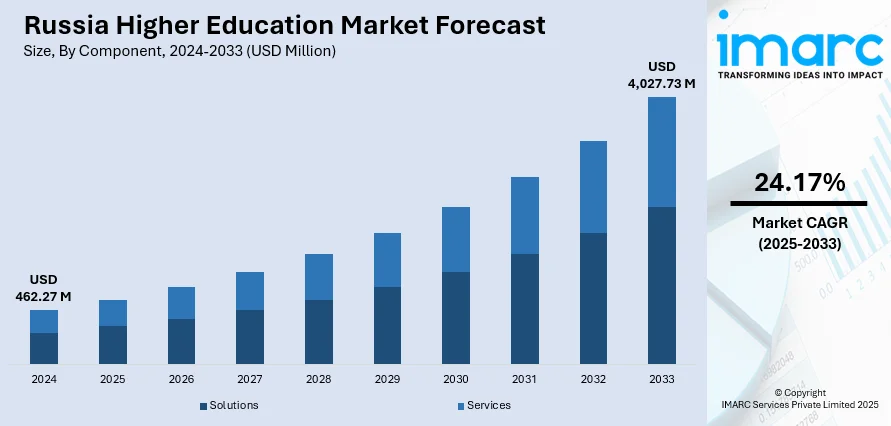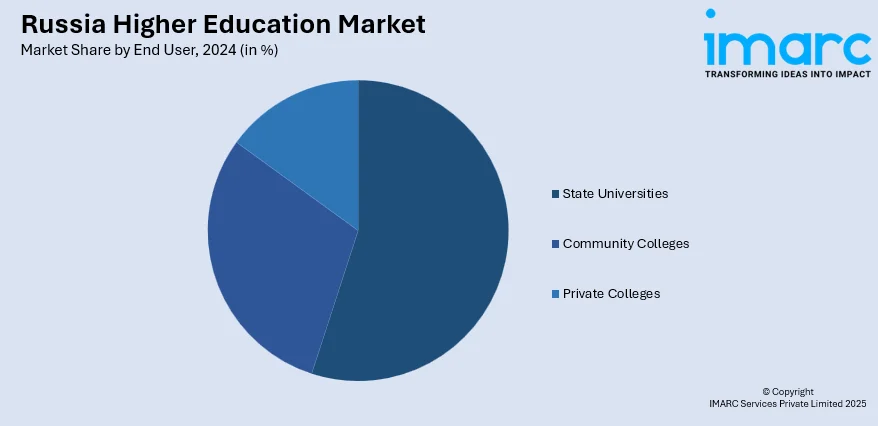
Russia Higher Education Market Size, Share, Trends and Forecast by Component, Deployment Mode, Course Type, Learning Type, End-User, and Region, 2025-2033
Russia Higher Education Market Overview:
The Russia higher education market size reached USD 462.27 Million in 2024. The market is projected to reach USD 4,027.73 Million by 2033, exhibiting a growth rate (CAGR) of 24.17% during 2025-2033. At present, increasing student enrollment in Russian universities is driving the demand for educational programs, enhanced infrastructure, and varied learning options. Besides this, the growing adoption of digital platforms that assist in refining the inclusivity of the education system is contributing to the expansion of the Russia higher education market share.
|
Report Attribute
|
Key Statistics
|
|---|---|
|
Base Year
|
2024 |
|
Forecast Years
|
2025-2033
|
|
Historical Years
|
2019-2024
|
| Market Size in 2024 | USD 462.27 Million |
| Market Forecast in 2033 | USD 4,027.73 Million |
| Market Growth Rate 2025-2033 | 24.17% |
Russia Higher Education Market Trends:
Increasing student enrollment
Rising student enrollment is positively influencing the market in Russia. As more students complete secondary education and seek advanced qualifications, universities across Russia respond by offering a wider range of undergraduate and postgraduate programs tailored to evolving job markets. The Russian Education and Science Ministry reported that as of May 2024, over 355,000 international students were enrolled in Russian universities. Acting Minister Valery Falkov stated that Russia possessed the sixth-largest number of international students worldwide. The steady increase in enrollment reflects the growing awareness among young people and families about the importance of higher education for career advancement and financial stability. This trend is encouraging the government and private institutions to invest in campus development and faculty training to meet rising expectations. Higher enrollment also leads to increased revenues, which universities reinvest in research, curriculum updates, and international collaborations. It aids in fostering competition among institutions, motivating them to improve quality, student support services, and employability outcomes. Additionally, the rise in enrollment attracts interest from foreign students, especially from neighboring countries, contributing to the internationalization of the sector. The larger student population also enables universities to strengthen partnerships with industries for internships, job placements, and curriculum alignment. As more young people are seeking degrees in areas, such as science, engineering, healthcare, and business, the higher education market is growing in both scale and sophistication in the country, reinforcing its role in national economic and social development.

To get more information of this market, Request Sample
Ongoing development of online learning platforms
Rising development of online learning platforms is impelling the Russia higher education market growth. As internet penetration is high and universities are adopting digital platforms, students are gaining the flexibility to learn at their own pace, which is increasing enrollment among working professionals, part-time learners, and those unable to attend traditional classrooms. As per industry reports, by early 2025, approximately 133 Million individuals in Russia were using the internet, indicating an internet penetration rate of 92.2% within the population. Digital platforms support a wide range of programs, ranging from technical and vocational courses to advanced academic degrees, enhancing the inclusivity of the education system. They also enable universities to update and deliver content more efficiently, integrating multimedia tools, interactive modules, and real-time assessments. Faculty benefit from tools that allow virtual collaboration, automated grading, and data-based student tracking. Online learning encourages collaboration between institutions through shared courses and advanced resources. Moreover, the rise of e-learning aligns with government goals to modernize the education system and promote digital literacy.
Russia Higher Education Market Segmentation:
IMARC Group provides an analysis of the key trends in each segment of the market, along with forecasts at the country and regional levels for 2025-2033. Our report has categorized the market based on component, deployment mode, course type, learning type, and end-user.
Component Insights:
- Solutions
- Student Information Management System
- Content Collaboration
- Data Security and Compliance
- Campus Management
- Others
- Services
- Managed Services
- Professional Services
The report has provided a detailed breakup and analysis of the market based on the component. This includes solutions (student information management system, content collaboration, data security and compliance, campus management, and others) and services (managed services and professional services).
Deployment Mode Insights:
- On-premises
- Cloud-based
A detailed breakup and analysis of the market based on the deployment mode have also been provided in the report. This includes on-premises and cloud-based.
Course Type Insights:
- Arts
- Economics
- Engineering
- Law
- Science
- Others
The report has provided a detailed breakup and analysis of the market based on the course type. This includes arts, economics, engineering, law, science, and others.
Learning Type Insights:
- Online
- Offline
A detailed breakup and analysis of the market based on the learning type have also been provided in the report. This includes online and offline.
End User Insights:

- State Universities
- Community Colleges
- Private Colleges
The report has provided a detailed breakup and analysis of the market based on the end user. This includes state universities, community colleges, and private colleges.
Regional Insights:
- Central District
- Volga District
- Urals District
- Northwestern District
- Siberian District
- Others
The report has also provided a comprehensive analysis of all the major regional markets, which include Central District, Volga District, Urals District, Northwestern District, Siberian District, and others.
Competitive Landscape:
The market research report has also provided a comprehensive analysis of the competitive landscape. Competitive analysis such as market structure, key player positioning, top winning strategies, competitive dashboard, and company evaluation quadrant has been covered in the report. Also, detailed profiles of all major companies have been provided.
Russia Higher Education Market News:
- In October 2024, the government of Russia announced the establishment of ‘packages’ for international students, which included travel expenses to the study location, housing, health insurance, and a scholarship. The government aimed to increase the enrollment of international students at domestic universities, including those from Western countries, by over 40% in the coming five years as part of a strategy to enhance the nation's worldwide presence. The government would review the possibility of increasing the current quota of state-supported spots for foreign students, which was around 30,000.
- In July 2024, the Russian Minister of Science and Higher Education, Valery Falkov, updated the President on the progress of the Advanced Engineering Schools federal initiative and the preparation of qualified personnel. The team allocated around 12 Billion during the initial two years, while the partners, which included 160 leading companies, provided 19.5 Billion. Russian regions put in more than one Billion. Overall, 11 of the 28 regions offered resources for the advanced engineering universities.
Russia Higher Education Market Report Coverage:
| Report Features | Details |
|---|---|
| Base Year of the Analysis | 2024 |
| Historical Period | 2019-2024 |
| Forecast Period | 2025-2033 |
| Units | Million USD |
| Scope of the Report |
Exploration of Historical Trends and Market Outlook, Industry Catalysts and Challenges, Segment-Wise Historical and Future Market Assessment:
|
| Components Covered |
|
| Deployment Modes Covered | On-premises, Cloud-based |
| Course Types Covered | Arts, Economics, Engineering, Law, Science, Others |
| Learning Types Covered | Online, Offline |
| End-Users Covered | State Universities, Community Colleges, Private Colleges |
| Regions Covered | Central District, Volga District, Urals District, Northwestern District, Siberian District, Others |
| Customization Scope | 10% Free Customization |
| Post-Sale Analyst Support | 10-12 Weeks |
| Delivery Format | PDF and Excel through Email (We can also provide the editable version of the report in PPT/Word format on special request) |
Key Questions Answered in This Report:
- How has the Russia higher education market performed so far and how will it perform in the coming years?
- What is the breakup of the Russia higher education market on the basis of component?
- What is the breakup of the Russia higher education market on the basis of deployment mode?
- What is the breakup of the Russia higher education market on the basis of course type?
- What is the breakup of the Russia higher education market on the basis of learning type?
- What is the breakup of the Russia higher education market on the basis of end-user?
- What is the breakup of the Russia higher education market on the basis of region?
- What are the various stages in the value chain of the Russia higher education market?
- What are the key driving factors and challenges in the Russia higher education market?
- What is the structure of the Russia higher education market and who are the key players?
- What is the degree of competition in the Russia higher education market?
Key Benefits for Stakeholders:
- IMARC’s industry report offers a comprehensive quantitative analysis of various market segments, historical and current market trends, market forecasts, and dynamics of the Russia higher education market from 2019-2033.
- The research report provides the latest information on the market drivers, challenges, and opportunities in the Russia higher education market.
- Porter's five forces analysis assist stakeholders in assessing the impact of new entrants, competitive rivalry, supplier power, buyer power, and the threat of substitution. It helps stakeholders to analyze the level of competition within the Russia higher education industry and its attractiveness.
- Competitive landscape allows stakeholders to understand their competitive environment and provides an insight into the current positions of key players in the market.
Need more help?
- Speak to our experienced analysts for insights on the current market scenarios.
- Include additional segments and countries to customize the report as per your requirement.
- Gain an unparalleled competitive advantage in your domain by understanding how to utilize the report and positively impacting your operations and revenue.
- For further assistance, please connect with our analysts.
 Request Customization
Request Customization
 Speak to an Analyst
Speak to an Analyst
 Request Brochure
Request Brochure
 Inquire Before Buying
Inquire Before Buying




.webp)




.webp)












